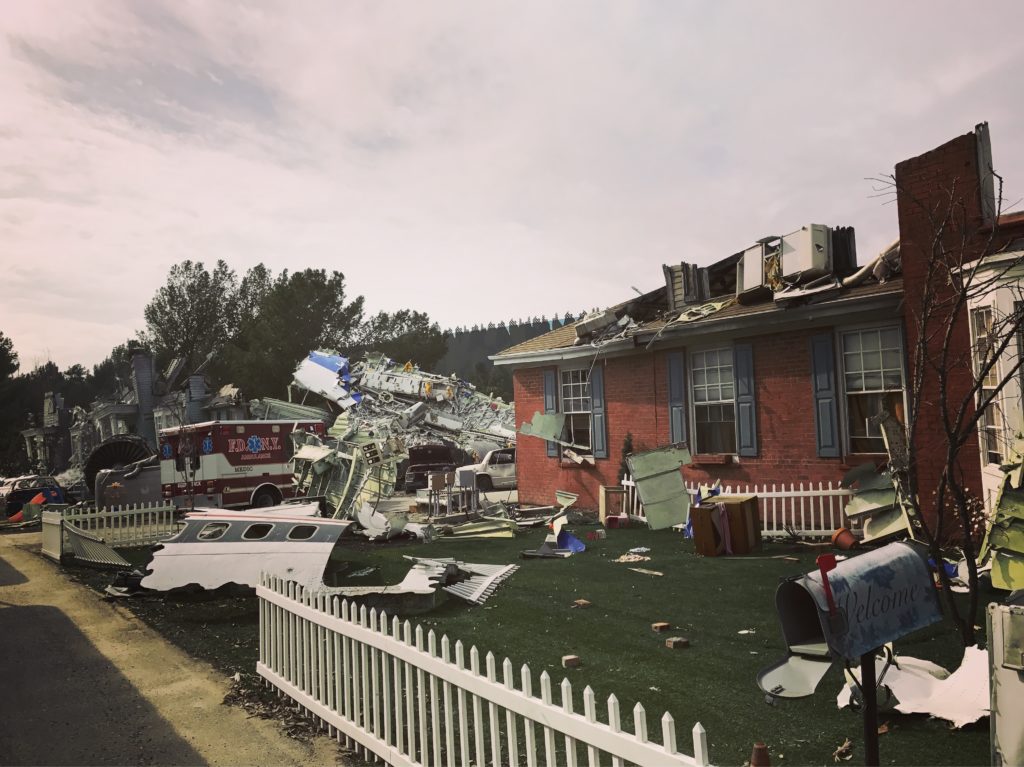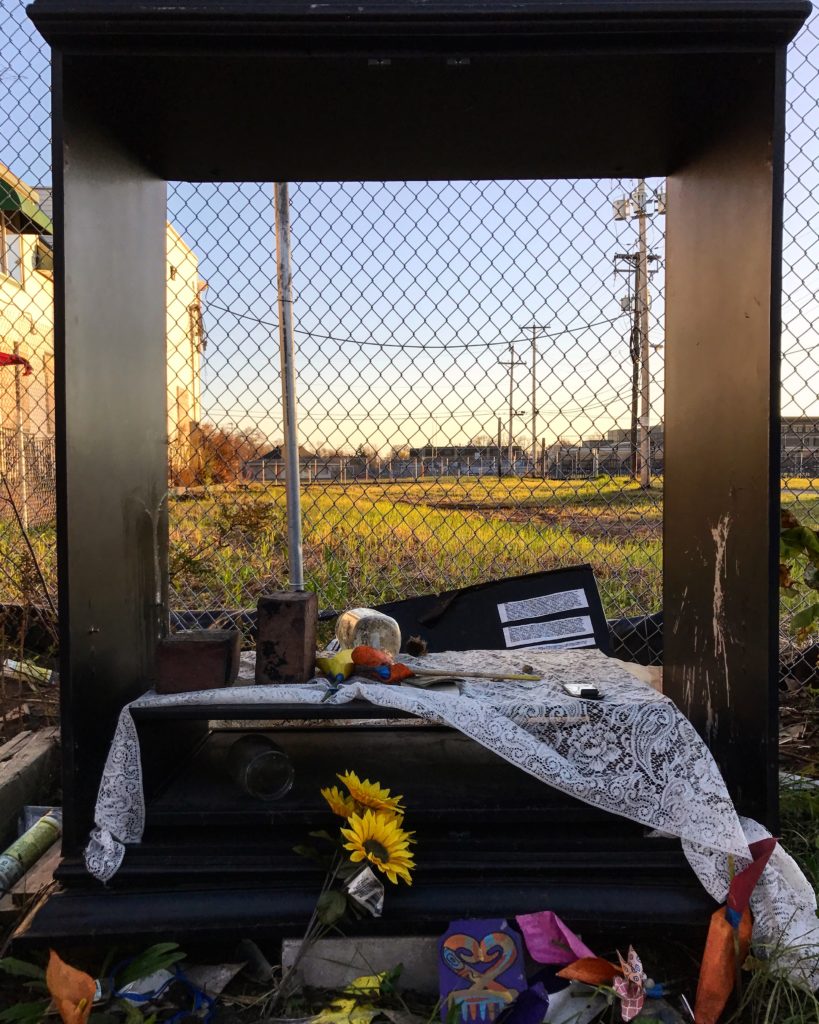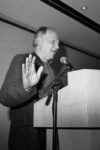
On April 20, 1999, high school students Eric Harris and Dylan Klebold committed what was at that time an unimaginable act of terrorism. In an extensively planned and coordinated attack, the boys murdered 12 students and one teacher, injured 24 more, and committed suicide before police were able to enter the building. If you wish to be kind to yourself, you will not read about the details of their attack—what they said to students as they opened fire, what injuries those who survived have sustained, nor their demeanor as they walked from the school’s cafeteria to the library to the science wing—nor would you read their journals, where they describe their ambition to rival the Oklahoma City bombing of 1995, both in scale and in terror. In scale, at least, the boys did not succeed.
It’s hard to write this now, after 18 years of watching one shooting after another unfold in the media. While “Columbine” has entered the American vernacular as a synecdoche for school shootings, its unique, unprecedented horror is long forgotten. Equally forgotten is the media frenzy that immediately followed the massacre, delving into the personalities, writings, friendships, and childhoods of Harris and Klebold in an attempt to find out, in that classic American way, “what went wrong.” Ultimately, the boys made it on the cover of Time. In doing this, said Marilyn Manson, “The media gave them exactly what they wanted.” In an interview two years after the shooting, Manson criticized the media’s role in the massacre: “If you die and enough people are watching, then you become a martyr, you become a hero, you become well-known. So when you have things like Columbine and you have these kids that are angry and they have something to say and no one’s listening, the media sends a message that if you do something loud enough and it gets our attention, then you will be famous for it.” In this, the boys unfortunately succeeded.
Another thing that’s easy to forget, all these years later, is Manson’s unwilling role in Columbine’s aftermath. While the killers did not like or listen to his music, several magazines and newspapers linked their appearance, actions, and desires with Manson’s image and his lyrics. Manson, on tour to promote the band’s 1998 album, Mechanical Animals, canceled all remaining tour dates due to protests and death threats. Months after the incident, he published an op-ed in Rolling Stone describing his choice “not to jump into the media frenzy and defend myself” against accusations, despite the evidence otherwise: “I didn’t want to contribute to these fameseeking journalists and opportunists looking to fill their churches or to get elected because of their self-righteous finger-pointing… I think that the National Rifle Association is far too powerful to take on, so most people choose Doom, The Basketball Diaries or yours truly. This kind of controversy does not help me sell records or tickets, and I wouldn’t want it to.” Instead of choosing a scapegoat or asking whether or not entertainment was to blame, Manson suggested that “media commentators [should] ask themselves, because their coverage of the event was some of the most gruesome entertainment any of us have seen.” Despite the fury over the event and the witch hunt that followed, Manson lamented that, “when these tragedies happen, most people don’t really care any more than they would about the season finale of Friends or The Real World. I was dumbfounded as I watched the media snake right in, not missing a teardrop, interviewing the parents of dead children, televising the funerals.” This, too, has become as familiar as the shootings themselves—one murderer after another on the front page of newspapers, as well as extensive reporting on their backgrounds, their psychological profiles, and their relationships.
A year after the massacre, Marilyn Manson released their fourth studio album, Holy Wood. With an illustration of Manson himself on the cover, his arms held out in a T and his jaw removed, the album is an exploration of the kind of celebrity only achieved through martyrdom and death. Aside from Christ, Manson’s lyrics contain allusions to Lennon and Kennedy, multiple references to state-sponsored executions, and themes of sainthood surrounding celebrity death. Most notably, he highlights the media’s death-obsession in a haunting quatrain on “The Nobodies”: “Some children died the other day / We fed machines and then we prayed / Puked up and down in morbid faith / You should’ve seen the ratings that day.” Ironically, when the music video for this song aired on MTV, the word “ratings” was censored; we could not know what it was that we should have seen.
***
Ratings are to television what click-counters and views are to online content: a way of quantifying your worth to those who decide to pay you. Both are measures of how many eyes have seen the products or services advertised in association with your editorial, artistic, or journalistic content. When ratings and clicks begin to influence the creative or editorial direction of that which is juxtaposed against these advertisements, we call this sensationalism.
Manson himself, whose entire career is built out of “shock,” controversy, and art direction, is obviously no stranger to this concept. With the 1996 release of Antichrist Superstar, Manson became a household name and media darling. All these years later, it’s hard to intimate to someone who wasn’t there just how ubiquitous Marilyn Manson really was, and how, at that time, the band brought mainstream music into a new theatrics of gruesome images, scandalous costumes, and music videos thenceforth unimagined by most American viewers and listeners. And this, he was unsurprised to learn, is exactly what made him a scapegoat after the Columbine massacre: “America loves to find an icon to hang its guilt on,” he wrote in Rolling Stone. “Admittedly, I have assumed the role of Antichrist… In my work I examine the America we live in, and I’ve always tried to show people that the devil we blame our atrocities on is really just each one of us.” For Manson, sensationalism has always been a deliberately artful indulgence. Even the band’s name, a compound of Marilyn Monroe and Charles Manson, reflects this critique of “the sad fact that America puts killers on the cover of Time magazine, giving them as much notoriety as our favorite movie stars.”
In the newsroom, however, sensationalism places truth subservient to profit. This is not a new argument, nor a controversial one; any reader or viewer willing to be honest with herself knows that the news she consumes is calibrated toward clicks, views, retweets, shares, and any other form of “buzz” it can generate. Even the arrangement of articles in a newspaper or on a website’s landing page reveals that publication’s allegiance to revenue. It’s not radical, either, to say that this prioritization of profit by major media organizations—including the neoliberal New York Times, CNN, and MSNBC, among others—is in large part what skewed the discourse leading up to the 2016 election, as well as the way each candidate was perceived. The majority of coverage Clinton received cast her as an untrustworthy, unlikeable, and professional candidate who would do little to change American politics. Trump, on the other hand, was portrayed as a dangerous and inexperienced wildcard; nearly every article was written through the lens of, “Can you believe he thinks this will work?” or “Can you believe he said this and got away with it?” Most front-page articles and top-circulated stories centered on Trump and his outlandish, “anti-establishment” behavior. Indeed, for a while it was hard to gauge Clinton’s policies at all, despite knowing from the beginning each and every promise Trump had ever made to his fan base.
Old wounds, these. The election is over, and it’s taken several months (as opposed to several minutes) for most media organizations to realize just how badly they fucked up. Some still haven’t figured this out. Now, in an unprecedented media takeover, Trump and his disastrous (but dangerous) administration is the dominant news story every single day. While polling lower than any president in history at the 100-day mark, his performance seems irrelevant—or perhaps adversely correlative—to journalists’ collective inability to look away. If presidencies had ratings rather than performance polls, this would be the most-watched, most-consumed, and highest-rated administration in world history. Which, despite a near total lack of policy implementation or laws passed, might have something to do with this former reality TV star’s insistence that his first 100 days are the most successful of any president before him. Before The Apprentice, Trump was a creature of the tabloids who gossiped about his marriages, his divorces, where he was seen in Manhattan, and what he’d done that week. Most of these stories were called into magazines directly, supposedly by Trump’s publicist—either a “John Miller” or a “John Barron”—but, as the New York Times revealed shortly after the election, in reality by Trump himself, trying to disguise his voice. Since his entire life seems to be a love affair with publicity, sensationalism, and attention, why should anyone expect him to feel as though he’s failed?
***
In the more convincing, successful, and sensitive passages (there aren’t many) of David Shields’s self-defined manifesto, Reality Hunger, readers are brought to believe that, over the course of Western civilization, what we call fact and what we call fiction have gradually borrowed from one another, and that now, in the 21st century, there is hardly any worth in separating them: “The techniques of fiction infected history; the materials of history were fed to the novelist’s greed.” In part, Shields attempts to explain the rise of “reality” in entertainment (especially television), which often does away with the pretense of scripts, scenery, character, and plot, though in fact utilizes, quite heavily, all of these elements in a more subversive fashion. Reality TV, as we’ve come to know it, is a far cry from the first seasons of The Real World, where real people spent most of their time sleeping or eating in front of a network of grainy surveillance cameras.
Twenty-five years later, reality TV is more formulaic than the prime-time sitcom ever was, and far more predictable than whatever new iteration of Law and Order is currently on the air. “I’m not here to make friends,” says at least one cast member at the beginning of every new season, no matter the show and no matter the consequences. Characters (selected by producers to form a matrix of opposing personalities) fight, scheme, gossip, cry, throw drinks, and, in general, get quite comfortable under their network of surveillance, always performing and yet never “acting.” That one never need know the exact circumstances behind a garden-variety reality show and yet still be drawn into it speaks to the producers’ innate talent to find a character whom every viewer can somehow relate to, whether through adoration, hatred, jealousy, or schadenfreude. It succeeds as a genre almost entirely on the basis of character, of personality, and what that character will say or do next. With the creation of Survivor in the late ‘90s, the introduction of “elimination” only galvanized this character-driven narrative: with each episode, your favorite personality was at risk of being voted off the show. In the early 2000s, this model of suspense propagated itself with competition-based shows like American Idol, The Bachelor, America’s Next Top Model, Top Chef, and, of course, The Apprentice.
While the premise of reality television is new—while, despite the scripts and precision casting, this is “reality unfolding before our eyes”—its character-based narrative of ongoing conflict is as old as television itself. While most early TV shows were episodic in their structure—introducing a conflict that would be resolved within 22 to 44 minutes—the soap opera has been a continuous, ongoing narrative since its initial inception. It’s the soap, in fact, from which reality TV borrows most of its tropes: natural enemies; longstanding grudges; the regular elimination of beloved characters; characters who reappear, seasons later, with much fanfare and surprise; and a constant series of cliffhangers, leaving the audience yearning to know what happens next. And it’s this trope, translated through reality television, that has been episodic entertainment’s death knell, especially in prime-time television. Instead of neatly packaged TV like Friends or E.R., America’s most talked-about dramas for the last 15 years have been narratives in serial. In Lost, Battlestar Galactica, Game of Thrones, Breaking Bad, Stranger Things, Orange is the New Black, etc., the credits signify anxiety rather than relief: our story has been interrupted and it will be a while (if we’re not binge-watching) before we know the rest. Even as far back as the early ‘90s, David Lynch and Mark Frost capitalized on this phenomenon with Twin Peaks, wherein the murder mystery is only an excuse to indulge a soap opera’s lust for keeping the audience on edge, for constantly denying the pleasure of release. In fact, Twin Peaks took the soap cliffhanger to its highest edge, with over 26 years between the disturbing final episode of its second season and the first episode of its third season, aired only this spring.
***
“Big changes are happening!” “We will deliver!” “Did Hillary know?” “The real story.” “Find the leakers.” “Much higher ratings at Fox.” “We will see what happens!”: These are a handful of sign-offs the president of the United States has used, over the last two months, on his personal Twitter account. With his unconstitutional executive orders, surprise bombings, revolving door White House staff, and relentless antagonism of everyone who doesn’t adore him, it should surprise no one that Trump is running his administration as though it’s a reality show. He even invited two “candidates” to the White House for his Supreme Court pick, intending to fill only one seat, as though it were a scene right out of Top Model. His stupidity and the banality of his language reduces him to a series of catchphrases—“We’ll see,” “Fake news,” “It’ll be beautiful”—which are magnetic for those whose lack of intelligence and/or empathy guide their support his way, and repellent for those of us who see him for what he is. But nobody can look away. The interest in Trump seems compulsory, a need to reassure oneself that the unbelievable is really happening, that satire is becoming reality. Meanwhile, the news cycle has accelerated to the point where the narrative of news itself is continuous. There are no breaks, no seasons, no episodes: just one unending cliffhanger, and all of us wondering whether or not we’ll die in a nuclear war before he leaves office.
 And of course, like other criminals before him, America gladly put him on the cover of Time.
And of course, like other criminals before him, America gladly put him on the cover of Time.
With Donald Trump, reality itself and reality TV have melded; unsurprisingly, this serial abuser has found a way to remove consent from viewership. He is the character who has forced his way into each of our lives, and it’s almost impossible to tune him out. In this way, he has achieved through the manipulation of sensationalist media what Marilyn Manson could not. In one of his most autobiographical songs, Manson tells us that, “Because today is black / Because there is no turning back / Because your lies have watered me / I have become the strongest weed.” While Manson’s reflection of American hypocrisy is pure artifice, a character he took on in the late ‘80s to represent the deadly seeds America would reap from its false narrative of innocence, Trump has blurred that line further; it’s no longer possible to tell whether or not Trump believes a single thing he says, or if a life of inhabiting an image has erased whatever personhood was once underneath altogether. If Marilyn Manson played America’s antichrist, Trump seems to be it.
From the perspective of the citizens he’s supposed to be leading, there is nothing beyond this performance he is both starring in and directing, despite all the articles, essays, and books that try to delve into his personality, his psychology. There is nothing that indicates a human being behind this spectacle. And in all the most grippingly operatic television, the character sincerely believes in the drama in which he is living. He believes in the righteousness of his actions. And he will act, as his catchphrases often threaten, even if that means wiping our civilization from the face of the earth. To pretend otherwise—to not take him at his word—is not just disingenuous and irresponsible; in trying to read a subtext that isn’t there—in looking beyond an image that’s lost its real-world referent—journalists and pundits risk, more than ever, getting someone killed.
This essay first appeared in the writer’s TinyLetter, Thread, which you can subscribe to here.
Patrick Nathan’s first novel, Some Hell, is forthcoming from Graywolf Press in February 2018. His writing has appeared in Boulevard, the Los Angeles Review of Books, dislocate, Revolver, Music & Literature, 3:AM, and elsewhere. He lives in Minneapolis.
This post may contain affiliate links.







